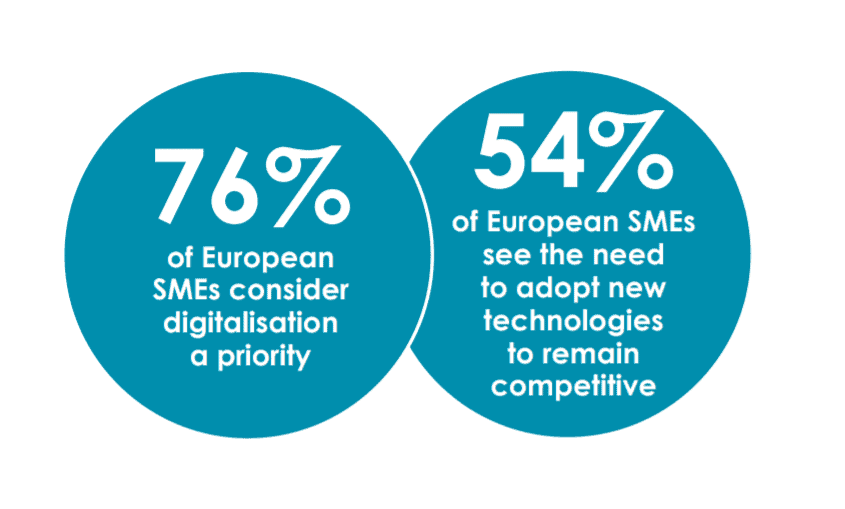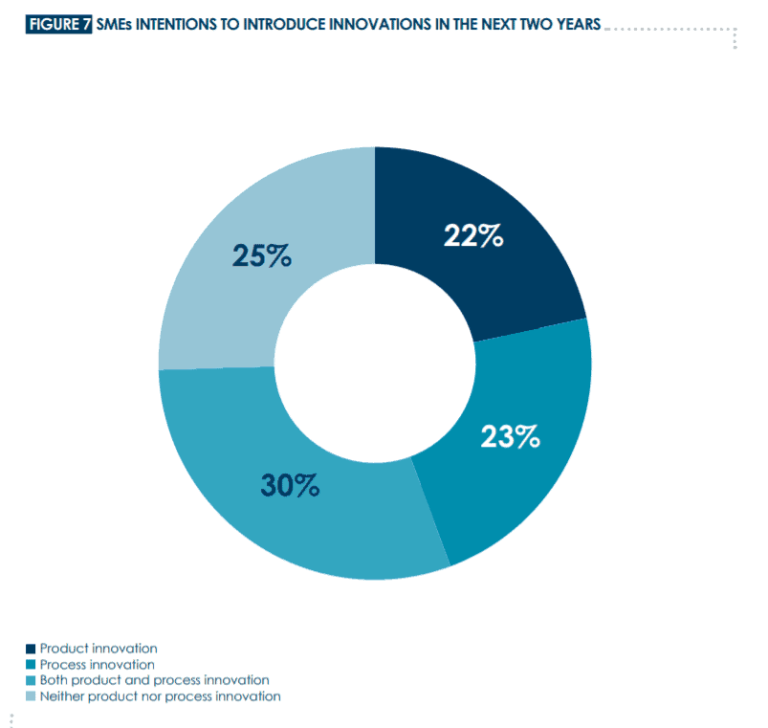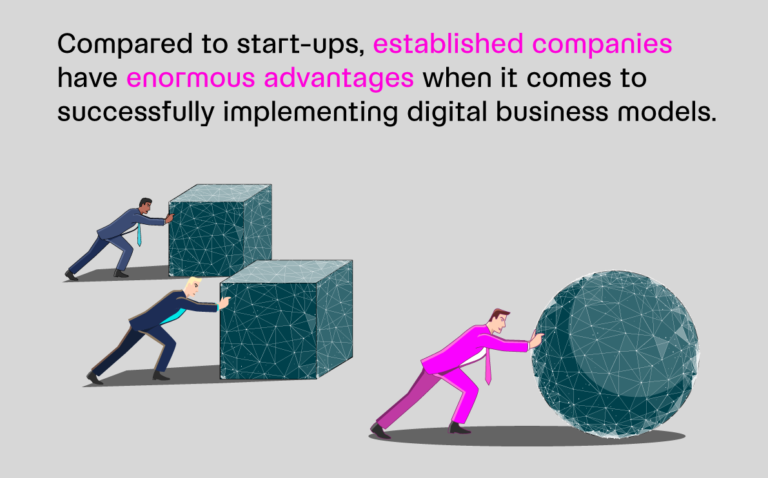Digital transformation does not only bring about new start-ups and technologies. It also brings major challenges for small and medium-sized enterprises. In order not to be beaten by the competition, even companies in a traditionally non-digital environment must consider how to integrate digital approaches into their business model. More and more companies are realising this. In a European study conducted by KfW Bank in 2019 in an international cooperation with other banks, at least one third of companies in every country said that digital transformation would be one of the major challenges in the coming years. Over 70 % are planning specific product or process innovations for the next two years.

Source: European SME Survey 2019: Going Digital – The Challenges Facing Europian SMEs.
Shaping digital transformation in small and medium-sized enterprises not only requires capital for the necessary investments, but also personnel and a changed corporate and leadership culture.
We explain what the four biggest challenges are for small and medium-sized enterprises when you want to integrate digital business models into your company.
Challenge No. 1: Leadership and error culture
Today, transformation processes are still initiated from the top down and thus the first challenge lies in a company’s management. The correct leaders are crucial for the success of digital transformation processes. If the leaders themselves are sceptical about these processes and want to stick to classic hierarchies, the leadership proves to be a brake on innovation.
Conversely, good leaders can not only accompany the transformation processes, but also contribute to their success to a great extent.
This starts with the error culture in the company. In medium-sized companies, zero-error policies still predominate. This means that mistakes should be avoided from the outset and those who make mistakes must fear sanctions.
It is not difficult to see why such a company policy is a massive brake on innovation. Employees are not motivated to think “out of the box” and take entrepreneurial risks; on the contrary, they are encouraged to do everything exactly the way it has always been done. Innovation dies at this point.
Many start-ups have this error policy ahead of the established medium-sized companies. Start-ups know that mistakes are part of every process. Mistakes can neither be forbidden nor avoided through pressure or similar measures.
Then how can you deal with mistakes?
Start-ups have learned to value mistakes. Because mistakes show what works and what doesn’t. Systematically making mistakes produces important insights that improve a product. This fail-fast principle is relevant in all areas of a company.
As a first step, companies that want to advance the digital transformation in-house should therefore acquire, train and/or motivate executives who themselves are enthusiastic about digital topics and have the corresponding know-how.
Challenge No. 2: Lack of innovative capacity
Even if there is a will to change within the company, digital transformation processes often fail due to a lack of innovative capacity.
What does this mean? Employees lack the necessary skills to support and actively shape transformation processes. Simultaneously, it is difficult for SMEs in particular to retain qualified staff because they do not offer the same attractive conditions as large DAX corporations and tech companies.
As a result, there is a lack of the necessary personnel, for example to support the digital infrastructure. In the KfW study of 2019, over 80 % of companies stated that they had faced obstacles in the context of digitalisation projects. These include, in addition to problems with poorly trained or unavailable staff, problems with data protection, a lack of financing options and poor internet connectivity.
There is no short-term solution to this challenge. Companies need to create a long-term culture of innovation that encourages employees to initiate and implement transformation processes. At the same time, existing staff must be trained.
Today, many employees have fundamental reservations about digital transformation processes, for instance because they fear rationalisation or have made themselves comfortable within existing structures. On the other hand, a culture of innovation and training makes the company more attractive for qualified staff. For the Millennial generation, for example, it is no longer primarily the salary and the company car that are decisive criteria for an employer, but also identification with the goals and values of the company.

Source: European SME Survey 2019: Going Digital – The Challenges Facing Europian SMEs.
Challenge No. 3: Inert structures and steep hierarchies
Old entrepreneurial structures reach their limits. Processes that have evolved over many years often turn every decision into a tedious bureaucratic task that takes an enormous amount of time. In an increasingly fast-paced environment, these sluggish structures become a major obstacle to innovation. Today, the company that is quickest to take up an idea and turn it into a product that satisfies the needs of the target group is often the one that can hold its own on the market.
Classic product development cycles cannot demonstrate this speed. They initially provide for a long research phase, after which a prototype is built. This prototype is then tested until it goes into series production.
In lean management, the concept of MVP is used instead. MVP stands for Minimum Viable Product. MVP development is about bringing a product to market as quickly as possible that has the necessary characteristics, and then analysing how the product performs in the market: What is the feedback from customers? What problems are there?
This feedback can then be incorporated into the next iteration of the product. This way, companies get feedback on their product quickly and do not run the risk of having spent a lot of money on research and development of a product that completely misses the needs of the customers or the reality of the market.
Such an approach only works, however, if the processes in the company are designed in such a way that they can keep up with this pace. In traditional corporate hierarchies, there is always an eye of a needle through which all decisions have to pass. If these hierarchies are flattened by decentralising decision-making, this eye of the needle disappears and decisions can be made and implemented much faster overall.
This does not mean that there can only be one true organisational structure that is able to keep up with the demands of the digital transformation. Which model is suitable for a company also depends on the status of the transformation processes in the company.
If a company hires new staff to tackle digital tasks in the company, it makes sense, especially in the beginning, to create a central division for digital matters in order to quickly accumulate know-how and build up a corresponding infrastructure. This only works in a structure in which the individual departments and teams work and communicate closely with each other. A central department helps to shape this cooperation until it is incorporated into the organisational structure.
Challenge No. 4: Selecting the appropriate technology
Technology itself also poses challenges for SMEs. Nowadays, most companies are already digitally positioned, at least in certain areas. This is most often the case in areas such as invoicing, which was digitalised early on. Tools for communication within the company are also standard for 60% of SMEs today. However, the big buzzwords of the last few years, “big data” and “artificial intelligence”, only play a role in 32 % and 20 % of companies respectively.
This shows that in many areas, digital transformation is still in its infancy. Especially the newer technologies overwhelm companies. They are confronted with a difficult-to-understand market of technical solutions whose advantages and consequences are hard to assess if the corresponding know-how is lacking. Before making large investments in technologies whose effects are not understood, small and medium-sized enterprises therefore remain hesitant. No matter what problem companies want to tackle: The technical solutions on offer are almost unmanageable. At the same time, choosing the right technologies and standards has great significance for future work and product.
This problem can only be solved by qualified people who know the technology market and can thus determine which tools, technologies and standards make sense for the respective company.
Digital transformation in SMEs: mastering challenges and seizing opportunities
Digital transformation will remain with all companies for some time to come. The sooner small and medium-sized enterprises address the challenges, the sooner they will be able to use the resulting effects to better position themselves against the competition. This change must begin in leadership culture. If managers create a positive environment, the attractiveness of the company for urgently needed skilled workers who implement the transformation processes also increases. Such an environment not only rewards new ideas and the will to innovate, but also provides a structure in which new ideas can be quickly implemented and tried out. This path is difficult and paved with various obstacles. But companies do not have to go down this path alone. A qualified external advisor can help, especially in the initial phase, to put the project on a solid footing and thus contribute to making the digital transformation in the company a success story.




